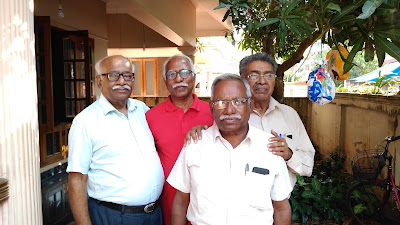Senior
artist N Balamuralikrishnan’s painting exhibition, ‘Memoirs of
Onattukara’ is a thought-provoking one
Photos: N. Balamuralikrishnan. Paddy fields. A telecom tower. Pics by Arun Angela
By
Shevlin Sebastian
As
one stepped into the ‘Memoirs of Onattukara’ exhibition by artist
N Balamuralikrishnan, at the Durbar Hall Gallery, Kochi, a large
canvas catches the eye. It is almost like a drone’s eye view of
several green paddy fields stretching out in the distance with green
parrots flying above it, along with a white swan. In front, are
several golden sheaves of paddy. It brings a moment of tranquillity
as one stares at it. But immediately next to this 14’x 4’ acrylic
on canvas is an image of a hill seen between the bars of a telecom
tower. And that sets the tone for the exhibition.
On
the opposite side, on a large black-and-white canvas, a lorry is
dumping waste on a patch of land. But when you look closely at the
garbage, you can see an owl, rabbit, tortoise, mouse, frog, snail,
beetle, and a mouse trapped in it. In another image, a paddy field
next to a railway line is filled with pieces of stone.
“My
hometown of Onattukara has changed,” says Balamuralikrishnan. “In
the name of development, forests and paddy fields have been
flattened. Buildings have come up. Telecom towers have been installed
in sacred groves. This has spoilt the harmony of the place. Money has
been coming from the Malayalis living in the Gulf and is causing
rapid changes.”
Balamuralikrishnan
had created an image of a man carrying large plastic materials like
buckets, mugs, brooms, ladles, pots and chairs on a bicycle. “The
arrival of plastic has also caused a lot of damage,” he says.
For
several years Balamuralikrishnan had been an art teacher in a
government school in Kannur. But in 2013, after taking voluntary
retirement, he returned to his hometown and was able to observe the
changes first-hand.
He
also focused a bit on history. In one image, the head of a statue of
Lord Buddha, with a topknot, can be seen nose-deep inside a lake. At
the side, broken columns are lying about, with grass growing over
it.
The
Hindu sage and reformer Chattampi Swamikal (1853-1924) while visiting
Mavelikara saw women washing clothes by hitting the stone of a statue
which was three-quarters below the surface of a river. Sensing there
was something more, with the help of the local people, Chattampi was
able to bring up the statue of Lord Buddha. And today, it has been
put in a place of prominence.
In
the eight century, the Onattukara area was a flourishing centre for
Buddhist culture. Many villages and towns had names ending in Palli,
which was common in Pali, the language of Theravada Buddhism. But
soon Hinduism reasserted itself. As a consequence, Buddhism faded
away.
Meanwhile,
on one side, Balamuralikrishnan has done several small charcoal
drawings within the frame of a canvas. In one, a bare-bodied man,
with palms upraised, near his face was shouting “Hoi Hoi”, to
warn lower-caste people to stay away. Behind him was a horse-drawn
carriage, which had an upper-caste passenger. When they went past a
school, social reformer TK Madhavan, who was a child then, mimicked
the sound of “Hoi, Hoi.”
The
carriage moved on. After several hours, two men came to find out who
had shouted. The children and teachers remained silent. But Madhavan
confessed and was beaten up.
“It
was a time when workers also had to hide when a member of the upper
caste walked on the road,” says Balamuralikrishnan.
But
there was a path to freedom. Another image showed a tall, bearded
Christian priest, in a white cassock, arms upraised, while on the
ground in front of him sat several downtrodden people. “Because of
the priest’s help the lower castes were able to get access to
education and by adopting Christianity they could walk anywhere,”
says Balamuralikrishnan.
Other
images include members of the Communist Party holding aloft their
hammer and sickle flags, as they took out a demonstration, a boat on
a river and an autorickshaw, with a loudspeaker on top, announcing a
death.
All
in all, this senior artist’s exhibition, comprising 21 works, is a
thought-provoking one.
(The
New Indian Express, Kochi)




















